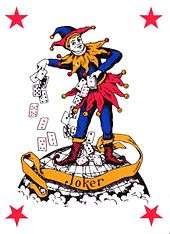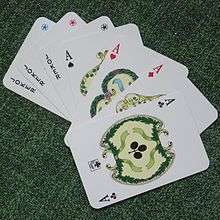Joker (playing card)

The Joker is a playing card found in most modern card decks, as an addition to the standard four suits (clubs, diamonds, hearts and spades). Originating in the United States during the civil war, the card is unique in that it lacks an industry-wide standard appearance. Created as a trump card for Euchre, it has since been adopted into many other card games where it may function as a wild card.
Origin

In the game of Euchre, the highest trump card is the Jack of the trump suit, called the right bower (from the German Bauer); the second-highest trump, the left bower, is the Jack of the suit of the same color as trumps.[1][2] Around 1860, American Euchre players may have devised a higher trump, the "Best Bower", out of a blank card.[3]
Samuel Hart is credited with printing the first illustrated "Best Bower" card in 1863 with his "Imperial Bower".[4][5] Best Bower-type jokers continued to be produced well into the 20th-century. Cards labelled "Joker" began appearing around the late 1860s with some depicting clowns and jesters. It is believed that the term "Joker" comes from Juker or Juckerspiel, the original German spelling of Euchre.[6][7] One British manufacturer, Charles Goodall, was manufacturing packs with Jokers for the American market in 1871.[8] The first joker for the domestic British market was sold in 1874.[9]
The next game to use a joker was poker around 1875 where it functioned as a wild card.[10] Packs with two jokers started to become the norm during the late 1940s for the game of Canasta.[11][12][13] Since the 1950s, German and Austrian decks have included three jokers to play German rummy; in Poland the third joker is known as the blue joker. In Schleswig-Holstein, Zwicker decks come with six jokers.[14]
Appearance
As a recent introduction to the pack, jokers do not have any standardized appearance across the card manufacturing industry. Each company produces their own depictions of the card. The publishers of playing cards trademark their jokers, which have unique artwork that often reflect contemporary culture.[15] Out of convention, jokers tend to be illustrated as jesters. There are usually two Jokers per deck, often noticeably different. For instance, the United States Playing Card Company (USPCC) prints their company's guarantee claim on only one. More common traits are the appearance of colored and black/non-colored Jokers. At times, the Jokers will each be colored to match the colors used for suits; there will be a red Joker, and a black Joker. In games where the jokers may need to be compared, the red, full-color, or larger-graphic Joker usually outranks the black, monochrome, or smaller-graphic one. If the joker colors are similar, the joker without a guarantee will outrank the guaranteed one. With the red and black jokers, the red one can alternately be counted as a heart/diamond and the black is used to substitute clubs/spades. The Unicode for playing cards provide symbols for three jokers: red, black, and white.
Many decks do not provide the Joker with a corner index symbol, of those that do, the most common is a solid five-pointed star or a star within a circle. It is also very common for decks to simply use a stylized "J" or the word "JOKER" in the corner.
Like sports trading cards, jokers are often prized by collectors. Many unusual jokers are available for purchase online while other collectible jokers are catalogued online for viewing.[16]
Tarot and cartomancy
The Joker is often compared to "(the) Fool" in the Tarot deck. They share many similarities both in appearance and play function. In Central Europe, the Fool is the highest trump; elsewhere as an "excuse" that can be played at any time to avoid following suit but cannot win.
Practitioners of cartomancy often include a Joker in the standard 52-card deck, with a meaning similar to the Fool card of Tarot. Sometimes the two Jokers are used: one approach is to identify the "black" Joker with the Fool and the "red" Joker with "the Magician," also known as the Juggler, a card which is somewhat similar in interpretation and is considered the first step in the "Fool's Journey."
Use of the Joker in card games

In a standard deck, there are usually two Jokers. The Joker's use varies greatly. Many card games omit the card entirely; as a result, Jokers are often used as informal replacements for lost or damaged cards in a deck by simply noting the lost card's rank and suit on the joker. Other games, such as a 25-card variant of Euchre which uses the joker as the highest trump, make it one of the most important in the game. Often, the joker is a wild card, and thereby allowed to represent other existing cards. The term "joker's wild" originates from this practice, as does the game show of the same name. The Joker Is Wild is also the name of a 1957 film starring Frank Sinatra.[17]
The Joker can be an extremely beneficial, or an extremely harmful, card. In Euchre it is often used to represent the highest trump. In poker, it is wild. However, in the children's game named Old Maid, a solitary joker represents the Maid, a card that is to be avoided.
Specific ranks
- Euchre, 500: As the highest trump or "top Bower".
- Canasta: The joker, like the deuce, is a wild card. However, the joker is worth 50 points in melding, as opposed to 20 for the deuce.
- Gin Rummy: a wild card, able to be used as any necessary rank or suit to complete a meld.
- Chase the Joker: An alternative version of Old Maid where the Joker card is used instead of the Ace.
- War: In some variations, beats all other cards.
- Pitch: A point card in some variations. Jokers usually are marked as "High" and "Low", one outranking the other.
- Mighty: Second most-powerful card in the game, though it cannot be legally played on the first or last trick.
- Daihinmin: a wild card, or a deuce (which ends the round and clears the discard pile).
- Crazy Eights: a "skip" card, playable on top of any other card, that forces the next player to lose a turn.
- Spades: uncommon, but can fulfill one of two roles. When playing with three or six players they are added to make the cards deal evenly (18 or 9 cards each, respectively). They are either "junk" cards playable anytime that cannot win a trick, or they count as the two highest trumps (the two Jokers must be differentiable; the "big Joker" outranks the "little Joker"). They also can be used in conjunction with teammates cards to create a pseudo-"trump", i.e. an Ace of Hearts and Joker played together would be counted as an Ace of Spades, inferior only to a natural Ace of Spades.
- Double King Pede: As the lowest-ranked card, but worth 18 points.
- Go Fish: In a game with two players, the joker pair is often used to bring the number of pairs to 27 and prevent a 13-13 tie.
References
- ↑ Parlett, David (1990), The Oxford Guide to Card Games, Oxford University Press, p. 190, ISBN 0-19-214165-1
- ↑ Beal, George. Playing cards and their story. 1975. New York: Arco Publishing Comoany Inc. p. 58
- ↑ Trumps The modern pocket Hoyle. 1868. New York; Dick & Fitzgerald. p. 94.
- ↑ Dawson, Tom and Judy. (2014). The Hochman Encyclopedia of American Playing Cards. Ch. 5.
- ↑ Wintle, Simon. Samuel Hart at The World of Playing Cards. Retrieved 17 July 2015.
- ↑ Parlett, David. Euchre at davidparlett.co.uk. Retrieved 17 July 2015.
- ↑ Joker at the International Playing-Card Society. Retrieved 17 July 2015.
- ↑ Wintle, Simon (10 April 2008). "The Evolution, History, and Imagery of Playing Cards". Collectors Weekly. Retrieved 2 October 2014.
- ↑ Goodall, Michael. (2001). "The Origin of the First English Joker". The Playing-Card Vol. 29, p.244-246
- ↑ Parlett, David (1990), The Oxford Guide to Card Games, Oxford University Press, p. 191, ISBN 0-19-214165-1
- ↑ Powills, Dorothy. (1989). "A Voice From the Past". Chicago Playing Cards Collectors Bulletin. Vol. 36-3, p. 1809.
- ↑ McLeod, John. (2005). "Playing the Game: Canasta Relatives". The Playing-Card, Vol. 34-2, p.141.
- ↑ Wintle, Simon. Canasta at The World of Playing Cards. Retrieved 17 July 2015.
- ↑ McLeod, John. Zwickern at pagat.com. Retrieved 17 July 2015.
- ↑ "playing card joker collection". dotpattern. 2003-06-07. Retrieved 2012-03-31.
- ↑ "joker web sites - alphabetical order". dotpattern. 2003-10-18. Retrieved 2012-03-31.
- ↑ "The Joker Is Wild (1957) - Overview". TCM.com. Retrieved 2012-11-13.
| Wikimedia Commons has media related to Jokers (playing card). |